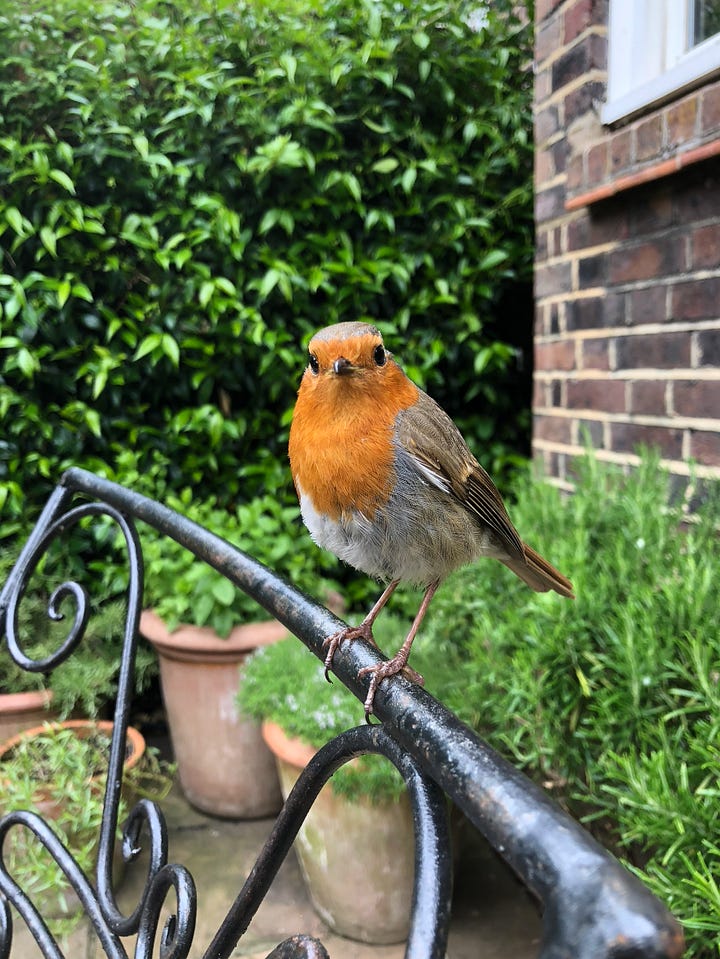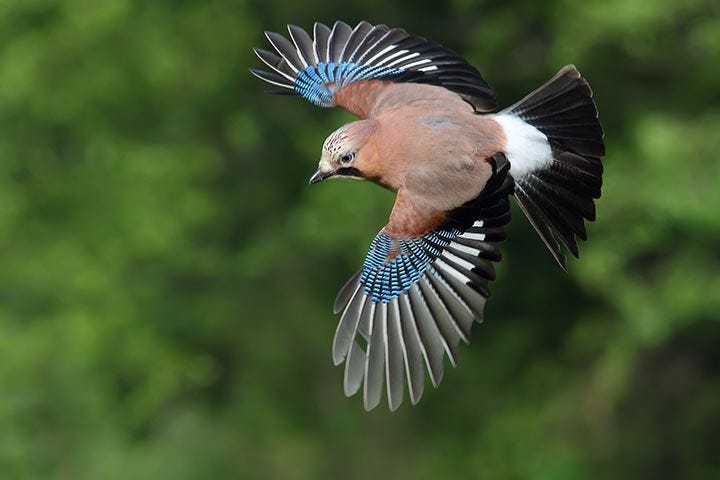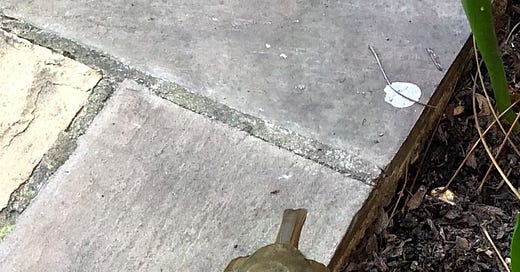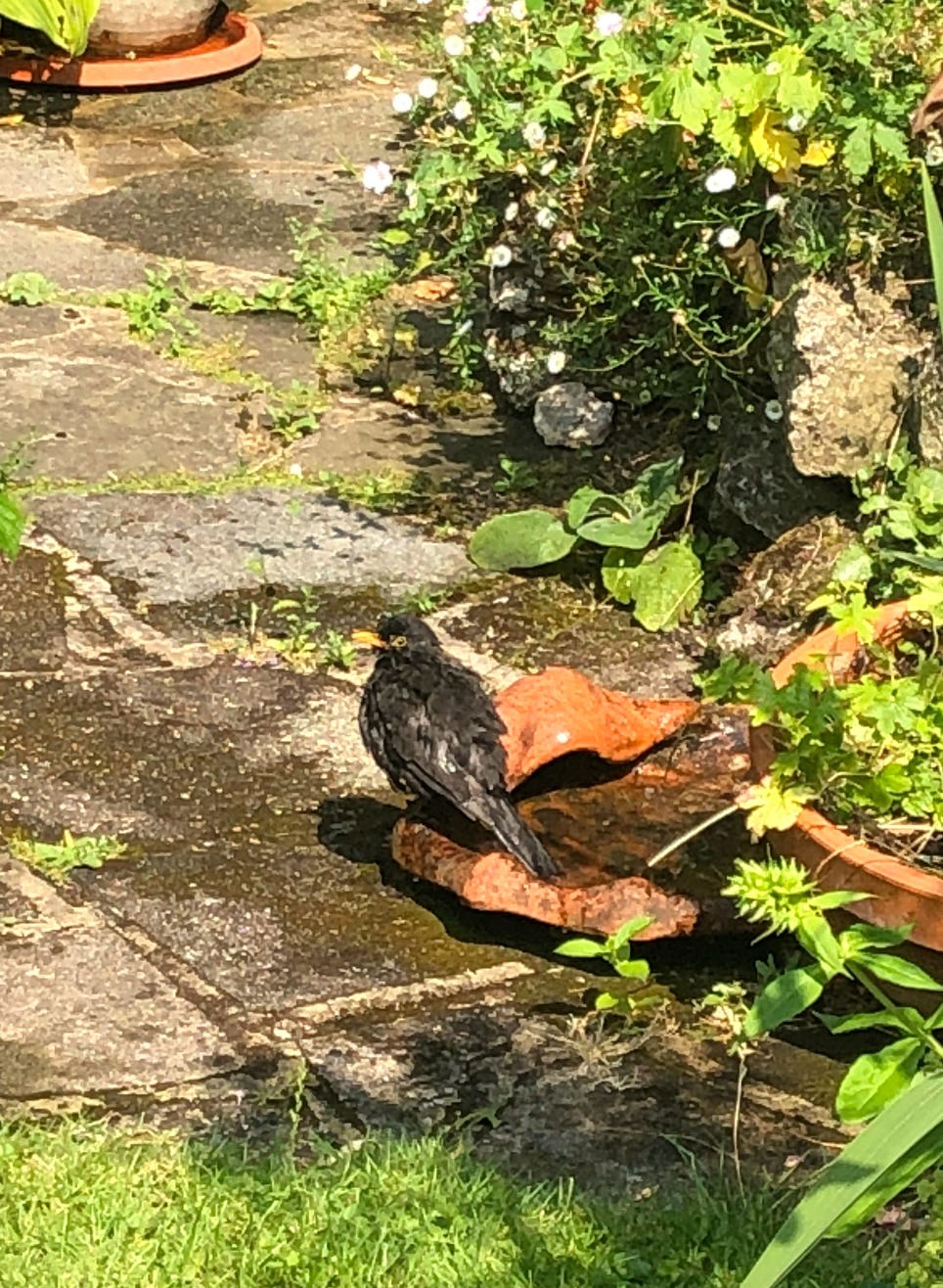A Gardener's Ramble on Neighbourhood Birds
Coo coo! Twit twoo! Stip stip stip! Tsee tsee tsee!
Do you know which birds sing outside of your window?
Do you pause and listen to the chorus of song birds communicating with each other?
I do and I always have.
The gentle coo cooing of the wood pigeon and the twitter of song birds indicate it’s dawn, around 5am. The twit twoo of the owl tells me it’s after 11pm or the middle of the night - the female owl singing the “twitt” and the male responds with the “twoo”.
I sometimes have to wake at 4:45am to collect a plant order - the sound of the birds outside is loud; and the air is full of song - so beautiful it can bring a tear to my eye.
Do you know why birds always sing loudest in the morning? There’s a few reasons. Firstly, sound travels better in cool, still air, so they will be heard more clearly; they sing loudly to reinforce their territory and also to attract mates. The low light makes it easier to forage for food too!
I don’t take bird song for granted and I’m always listening out for it. When out for a walk with my partner, I stop to observe the call of the song thrush (my favourite song bird) or to see if I can spot the woodpecker hammering away at a nearby tree.
I love the call of a male song thrush (only males sing) Turdus philomelos – beginning with a sort of alarm call: stip stip stip stip (repeated 2-4 times). I have a local song thrush which sings from my client’s chimney, giving me a moment to awe at this tiny bird’s magnificence.
They are a little smaller than a Blackbird, with the most beautiful patterned feathers. It usually has a favourite stone used to break snail shells, known as an “anvil.” You can find these “anvils” if you spot many broken littered snail shells and a nearby stone :-)
I’ve always known the birds to sing, they’ve been singing since my birth and they still continue to play a huge part in connecting me to the natural world. Birds form the backdrop of civilisation, we expect birds to sing and to appear in our gardens, alike the way we expect fish to populate the sea.
Recently, I woke to the sound of silence and it brought a heavy feeling of concern - it remained silent for some time until a robin broke the silence. The robin has become a good friend - this bird has loyally followed me around the garden for the past two years and I now bring seed now to feed it while I work.
I work alone and have a lot of time to enjoy my surroundings or to notice any small changes in the garden. I know which birds to expect in which garden - a pair of Jay birds visit me on a Tuesday and sometimes, if i’m lucky, a naughty heron with an appetite for the carp in the pond (all safely netted so I see it less and less now). Another is the robin below, appearing on a Monday, once I begin to weed and tidy the borders, it happily hops behind me collecting worms.


However, sadly the bird population is dropping. Here’s why (of course climate change related) :
Habitat disruption - warmer temperatures and changing rain fall patterns are affecting wetlands, woodlands, and moorlands that birds rely on for nesting and feeding, especially wading birds, which are very water dependant.
Mismatched timing + food chain disruption - bird breeding should coincide with peak food availability however, now with our warmer springs, insects emerge earlier so when the birds’ offspring hatch, food is scarce.
Extreme weather - heat waves, floods, storms are dangerous for nesting birds. It also effects their migration routes, for example, the starling does migrate from northern / eastern Europe and also Scandinavia to come to the UK.
Sea level rising - puffins and terns are having their coastal habitats and nesting grounds destroyed, therefore less breeding success.
Range shifts (refer to changes in the geographical area where a species lives, typically caused by environmental change)
the egret prefers the UK now originally from Northern Europe / Africa / Asia and Australia as it likes our warm climate as it’s warmer.
Native UK birds like the snow bunting are relocating to Scotland as it’s too warm, preferring cooler temperatures.
Even worse, migratory birds may change their migration timing or stop shorter distances.


Jay - Garrulus glandarius
Recently, I was working in a garden and watched a Jay bird land in a client’s apple tree. It looked at me for a moment and decided I wasn’t a risk - continuing to hop along the border from tree to tree. It finally stopped at a tired shrub and used its beak to tug at a dead branch. It had no luck so moved onto another shrub.
I watched its eyes swivel again at me to check I hadn’t moved, then around the tree, sizing up the branches. It carefully clasped the branch between its beak and snapped off the twig, flying to join its mate who appeared at the other end of the garden.
Their diet consists of acorns, nuts, seeds and insects, but also eats nestlings of other birds and small mammals. They can carry up to 5 acorns at one time carrying 2-3 acorns in the throat pouch, one in their mouth, and one on the tip of their beak. They bury acorns and return to dig them up in winter.
They make a loud squawking song as they belong in the Corvidae family and are native to a wide variety of areas, from western Europe, northwest Africa, the Indian subcontinent, and parts of Asia and lucky for us - they are widespread across the UK!

How you can help the birds?
Merlin bird ID - it can identify which bird is singing, free of charge and an eye opening app.
Donate to BTO - British Trust for Ornithology
Fill up bird baths so birds can drink through autumn and wash during summer, especially when it’s very hot! In winter, break ice to keep water accessible too.
During winter, leave out high fat foods and keep bird feeders clean to avoid the spread of disease.
When planting your garden, include trees like Amelanchier larmarkii (june berry), Sorbus acucapria (rowan), Malus sylverstris (crab apple) or Prunus avium (wild cherry). These all provide fruit or berries for our little feathery friends.
Avoid using pesticides or weedkillers to encourage beneficial insects into our garden to provide food. Consider growing native wild flowers too :-)
Be careful not to cut any hedges containing nests (generally from March - July) - it’s illegal under the Wildlife and Countryside Act (1981).
Put up nesting boxes for species like blue tits, robins, wrens, and starlings
Put a bell on the cat! Birds were here first and they don’t understand cats existence and don’t expect them to appear. Did you know birds have existed in the UK for millions of years, whereas cats were only introduced around a thousand years ago? Cats have made a real dent in the bird population - they already have plenty of cat food and don’t need to fill up on local pigeons.
Final gardening note
I’m very proud of this stunning bulb display I put together. I added Tulipa ‘Blue Aimable’ and camassias to a bed full of spanish bluebells and wild yellow poppies - I think it’s worked quite well. Camassia’s are great, they are perennial bulbs with tall spears of flower! Gorgeous.







Lovely letter Sarah, thank you! The birds here sound so different. My new favourite is called the Uguisu bird which is probably only my favourite because it’s the first one I can name by recognizing its call! Very beautiful sound though. I’ve heard it in the mountains and in the backstreets.. 8 look forward to learning more! Do you think the Merlin app only works in the UK? And yes that tulip display is stunning, well done 👏